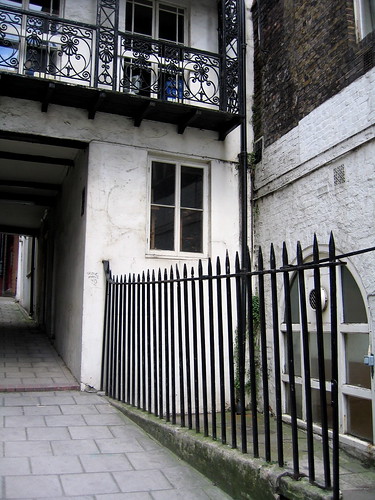Monday, January 31, 2005
London: Roman Baths

An American once told me in Vienna that the Strand possesses a Roman bath well worth seeing, but, being a good Londoner, I did not believe him -- until I went there.O credulous Morton! Architectural critic Nikolaus Pevsner(page 371 -- The Buildings of England: London and Westminster Simon Bradley and Nikolaus Pevsner. Yale), for one, thinks this unlikely: "David Copperfield took a cold plunge in it before setting off to walk to Hampstead." which is all very well, but he's fictional. "The dimensions of the bricks are not Roman, and the high ground level also rules out a Roman origin. More likely is that the bath belonged with ARUNDEL HOUSE, which would suggest a C16 or early C17 date." Case closed. So what you have in this back alley off the strand, is merely a 16th century bath -- an era not noted for bathing -- built by some aristocratic collector of antiquities. It dosn't really matter who built it. Its weird enough to find the alley with the bath. Its owned by the National Trust (check the link for directions etc.), but it is unattended. You push a light switch on a timer and peer down into what looks like a flooded basement (well lit, made of a khaki sandstone). It makes you wonder what's hidden around the next corner, what building has a lightswitch on it so you can peer inside. It is fantastic.
This Bath, which was constructed in A.D. 200 -- seventeen hundred years ago -- is opposite Bush House, in the Strand. Think of that. bush house and Rome! It is in the basement of No. 5 Strand Lane, an astonishing, a narrow, dingy alley that, in one step, takes you back to the darkest days of Victorian London, when lanterns glimmered in passages and 'Peelers' twirled truncheons and wore stove-pipe hats. No. 5 belongs to the Rev/ pennigton Bickford, Rector of St. Clement Danes, who bought the house a few years ago to save the bath, which was - O incredible London! - in danger of destruction.
Page 143 - Our Roman Bath. Notes from London by H.V. Morton - fifth edition, Methuen and Co, Ltd. London 1941
My friend Ben Chant, in his as yet unpublished Liars Guide to London (copyright Benedict Chant) imagines that the Roman Bath is part of a ancient Temple complex. Here he describes a visit:
Turn left out of the cafe and walk up Arundel Street until you reach Temple Place on your left. This is the site of the spectacular Roman Temple that gave the area its name. Follow the lane round to the right and ring the bell. The Temple is open from 9:00 a.m. to 9:00 p.m., but it's frequently rented out in the evenings to parties of lawyers and business people from the nearby Inns of Court or the City, so call ahead if you are planning to arrive after 6:00 p.m. The National Trust looks after the temple so there's no admission fee, just the venerable custodian standing next to a collection box as you enter. If you do donate something you'll find the staff eager to give you an informal tour. You should probably do this because although the temple appears to be simply designed (it was merely the "private chapel" of a minor Roman official), your guide can point out some peculiar details. Note, for example, the mosaics of exceptionally priapic rams and dolphin-boys playing in the water. The story goes that there is a room in the back of the temple with wall paintings that match the licentiousness of Pompeii's frescoes, but I have never been able to donate enough money to pry a definite "yes" or "no" from the guides.






